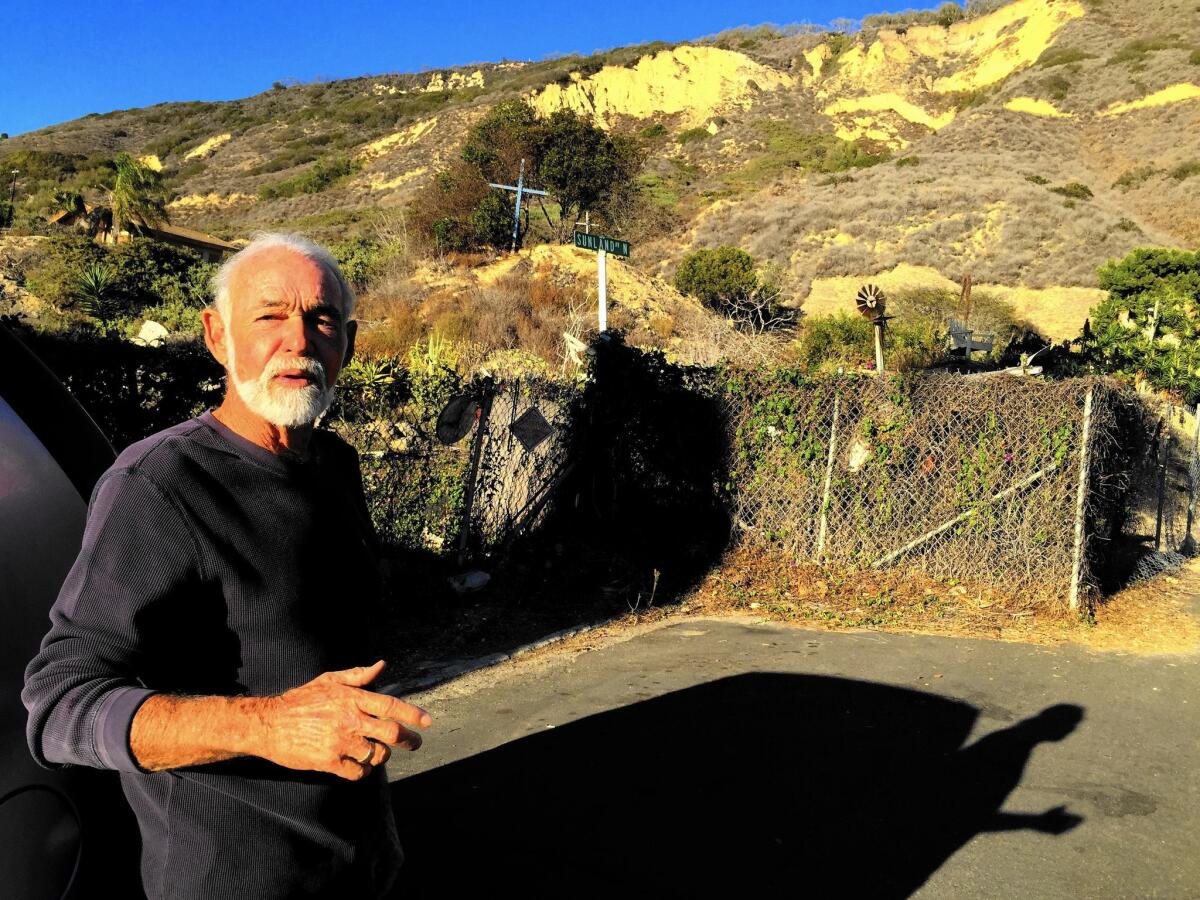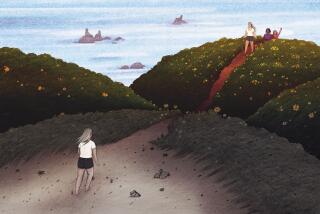As El Niño looms, La Conchita residents say ‘blue-collar affordability’ makes landslides worth risking

When the rains are heavy, Mike and Barbara Bell don’t sleep well. They get up to check their weather gauge. They peer at the water coursing past their home, searching for signs of mud. If the water is clear, they rest easy.
For that moment, at least, they don’t have to worry about the mountain falling on La Conchita again.
The last time it came down, on a January afternoon in 2005, 10 people died, including three young sisters. Fourteen others were injured; 15 homes were destroyed, 16 damaged. The time before that, in 1995, no lives were lost, but seven homes were destroyed. Geologists say the area has been plagued by landslides for thousands of years.
No one expects that to change.
Lately when I drive past La Conchita, which sits in isolated splendor at the bottom of a 600-foot cliff on the northeast side of Highway 101, I feel a certain dread. Doesn’t Bell feel it too?
“There’s nothing we can do,” he said.
Many believe the landslides were caused by heavy rains combined with poor water management practices at La Conchita Ranch, a 655-acre lemon and avocado farm that sits on top of the hill above the town.
The ranch was sued by survivors of the 2005 slide, who were given title to the property as part of a settlement. They sold it for a relative pittance, $2.5 million, to Andy Sheaffer, a Camarillo school board member who owns a slope stabilization company. He continues to farm the land. People I met praised the work he has done on drainage problems that contributed to the cliff’s instability.
“I think we’re just fine,” said Ray Gann, 68, who lives with his wife and 16-year-old son on Vista del Rincon, the street closest to the cliff, whose residents are at greatest risk. “Andy is a really good neighbor. One time a little mud came down, and he was down there with a truck and 2,000 premade sandbags and a crew, just like that.”
Still, when it rains, Gann parks his cars facing downhill.
::
Halfway between Ventura and Santa Barbara, La Conchita is an eclectic, 28-acre jumble of 161 stylish beach homes, trailers and shacks on about nine square blocks.
If they don’t mind looking across Union Pacific railroad tracks and the newly widened Highway 101, the town’s 330 residents have unparalleled views of the ocean, Santa Cruz Island and a handful of oil drilling platforms that are far enough away to be picturesque.
“Blue-collar affordability; that’s what it is,” said Bell, who bought his home in 1983 for $125,000.
In La Conchita, there is no gas station, no convenience store, no restaurant nor any public restrooms. No homeless people, either. After decades of promises, the town finally got a pedestrian underpass beneath the highway that connects its frontage road to the beach. Before the passage opened last year, you had to run across the highway or stoop through a 4-foot-high drainage pipe.
Bell, who founded the La Conchita Community Organization after the 2005 slide, has been haggling with Ventura County and Caltrans for most of the past year over a dolphin statue his group wants to place at the underpass. The statue, with seven adult dolphins frolicking with three young dolphins, would be a tribute to those who lost their lives in 2005.
The county is worried about liability, said Bell, 68. “What would happen if someone climbed it and fell?”
As we drove around town, we stopped to visit with Tom Fuller, 57, a civilian Navy employee, who was changing the oil in his SUV.
“We wouldn’t live anywhere else,” said Fuller, who raised two daughters here. “It’s ‘Father Knows Best.’ It’s ‘Leave It to Beaver.’ The community is so wonderful it’s embarrassing.”
Later, as Bell and I circled back past Fuller’s house, Fuller flagged us down. He stood at the window of Bell’s SUV.
“Can I say one more thing?” His eyes watered and he choked up.
“It’s OK, buddy,” said Bell, patting Fuller’s arm.
“I have terminal cancer,” Fuller finally said. “What is really cool is that at 2 in the morning, if my wife needs something, if anything happens to me, there would be a dozen people she could call to help her.”
::
In 2005, Bell was standing outside his house with a news crew when the mountain gave way. The journalists were in town to cover a voluntary evacuation recommended after record rainfall raised concerns about the integrity of the cliffs. They filmed the collapse.
There is no mistaking the scars the slides have left on the cliffs. A pair of wide, sandy gashes converge on a river of earth that flows downhill. If you follow that river of dirt to the bottom, you will be looking at the toe, or forward edge, of the landslide. A jumble of twisted homes is scattered at the bottom, left exactly where 456 tons of falling mountain pushed them nearly 11 years ago. Several mirrored crosses mark the spot where Michelle Wallet and her three little girls died.
A state study found that the hill could probably be stabilized at a cost of $50 million, but no one has the political will or might to take on such a project. The state has done nothing.
It seems unconscionable to me that a traumatized community would not have the right to remove the reminders of such tragedy, but Bell told me geologists don’t think it’s safe to clear the debris: “It would potentially allow the slide to slide again is what they said.”
Bell, and many experts, have no doubt the mountain will collapse again.
“I absolutely believe that,” he said. “All the reports I read will tell you someday that’s coming down again. But it’s only going to fall on what’s already there.”
That may be optimistic.
But when you wake up every morning to a million-dollar view at a fraction of the price in a place where people care about each other, you have every reason to want to stay.
Twitter: @AbcarianLAT







